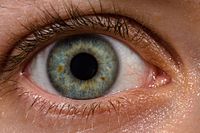
Photo from wikipedia
Background: Ulnar neuropathy at the elbow (UNE) is a debilitating upper extremity condition that often leaves patients with residual symptoms even after surgical treatment. The role of electrodiagnostic studies in… Click to show full abstract
Background: Ulnar neuropathy at the elbow (UNE) is a debilitating upper extremity condition that often leaves patients with residual symptoms even after surgical treatment. The role of electrodiagnostic studies in guiding the treatment of UNE is not well established, and conventional electrodiagnostic parameters may not reflect the severity of disease. Compound muscle action potential (CMAP) amplitude is a parameter that corresponds with axonal injury and motor symptoms and may more accurately predict the severity of neurologic injury. Methods: This prospective multicenter study recruited 78 patients in the Surgery of the Ulnar Nerve project. Patients underwent electrodiagnostic testing and clinical assessment of motor and sensory function, and completed patient-reported outcome questionnaires, including the Michigan Hand Outcome Questionnaire; the Disabilities of the Arm, Shoulder and Hand questionnaire; and the Carpal Tunnel Questionnaire (CTQ). Correlations were measured among each of the electrodiagnostic parameters and outcomes and predictive models for each outcome were subsequently developed. Results: Of all the electrodiagnostic parameters measured, only CMAP amplitude was predictive of scores on the Michigan Hand Outcome Questionnaire; Disabilities of the Arm, Shoulder and Hand questionnaire; CTQ function scale, and motor impairment in grip and pinch strength. None of the parameters were predictive of scores on the CTQ symptom scale or sensory impairments as measured with two-point discrimination or Semmes-Weinstein monofilament testing. Conclusions: CMAP amplitude, but not other conventional electrodiagnostic parameters, is predictive of functional outcomes in UNE. This electrodiagnostic measurement can alert the clinician to severe cases of UNE and inform surgical decision-making. CLINICAL QUESTION/LEVEL OF EVIDENCE: Risk, III.
Journal Title: Plastic and Reconstructive Surgery
Year Published: 2023
Link to full text (if available)
Share on Social Media: Sign Up to like & get
recommendations!